The Great Depression & WW II
Fighting the War
During World War II, most soldiers were never exposed to direct combat. For every B-17 or B-24 bomber with a flying crew of ten men, there were 20 to 25 men supporting them.
Cooks, laundrymen, postal workers, armorers, mechanics, electricians, pay clerks and administrators served just as surely as the crew. Some soldiers never left U.S. soil.
Other uniformed men saw combat within the first few months of war. Sailors, deployed on aircraft carriers that had not been at Pearl Harbor, fought Japanese naval and air forces in the Battle of Coral Sea in May 1942. The next month, these carriers won a decisive victory at the Battle of Midway.
Cooks, laundrymen, postal workers, armorers, mechanics, electricians, pay clerks and administrators served just as surely as the crew. Some soldiers never left U.S. soil.
Other uniformed men saw combat within the first few months of war. Sailors, deployed on aircraft carriers that had not been at Pearl Harbor, fought Japanese naval and air forces in the Battle of Coral Sea in May 1942. The next month, these carriers won a decisive victory at the Battle of Midway.
After basic training, some soldiers were sent overseas to fight. They were put on transport ships, often sleeping six or seven bunks high with barely enough room to roll over. Usually they were sent first to Great Britain and later to North Africa where American troops first saw combat in late 1942.
In Europe, American bombers begin bombing raids over Germany in August 1942. But they incurred heavy losses at first.
Combat was often personal, fought building by building, foot by foot. Soldiers had to learn to deal with the stress and the fear of dying. Most did by not thinking about it—just assuming they would make it through. But when they lost a friend or a member of their unit, the reality of what they were doing would come back.
As one veteran said, “I was in combat for six weeks, but I could remember every hour, every minute of the whole 46 days.”
African Americans were still segregated by units, mess halls, barracks, and bars both in the United States and overseas. There were nine black field artillery battalions and a half dozen tank battalions. By the end of the war, many white commanders felt that black troops could be assigned to fight alongside whites. President Harry Truman integrated the armed forces in 1948.
Read about some Tennesseans who fought in the war
Read about prisoners of war during World War II.
African Americans were still segregated by units, mess halls, barracks, and bars both in the United States and overseas. There were nine black field artillery battalions and a half dozen tank battalions. By the end of the war, many white commanders felt that black troops could be assigned to fight alongside whites. President Harry Truman integrated the armed forces in 1948.
Read about some Tennesseans who fought in the war
Read about prisoners of war during World War II.
Picture Credits:
- American paratroopers dash through an open field in the assault in Holland amid exploding German shells in October 1944. U.S. Army photograph. Tennessee State Museum Collection
- U.S. medic Pfc. Harvey White gives blood plasma to Pfc. Roy Humphrey after he was wounded by shrapnel (metal fragments that are scattered when a shell or bomb explodes) on August 3, 1943 in Sicily. National Archives
- A photograph of B-17 Flying Fortresses on a bombing run to Germany in April 1945. United States Air Force
- Photograph of part of an all-black U.S. Army unit. These soldiers are probably clerks using field desks to prepare communiques for the rest of the unit. The photograph was taken in September 1943 in Italy. U.S. Army
- American warships move in a line on the way to the invasion landing on Luzon in the Philippines in January 1945. The first ship is the USS Pennsylvania battleship. National Archives
- Soldiers had to eat and sleep wherever they happened to be fighting. Here members of the 347th Infantry Regiment stop in the snow for food on their way to La Roche, Belgium, in January 1945. National Archives
The Great Depression & WW II >> World War II >> Fighting the War >>
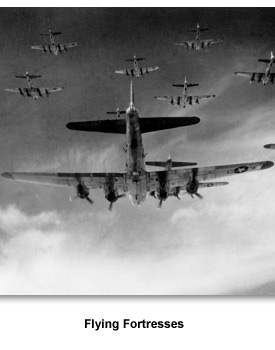
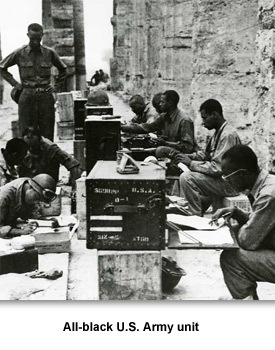
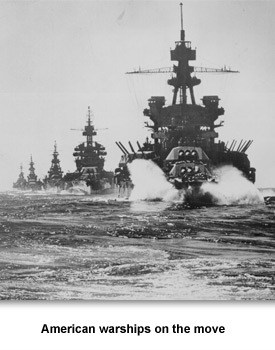
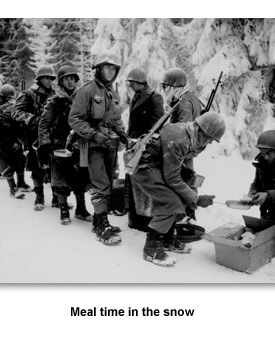
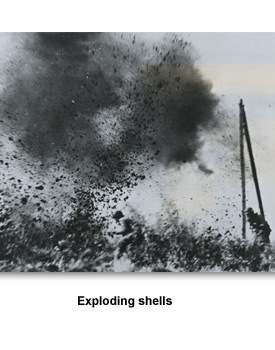
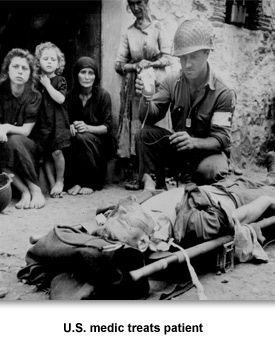
 Sponsored by: National Endowment for the Humanities
Sponsored by: National Endowment for the Humanities